
Frogfishes are any member of the anglerfish family Antennariidae, of the order Lophiiformes. Antennariids are known as anglerfish in Australia, where the term "frogfish" refers to members of the unrelated family Batrachoididae. Frogfishes are found in almost all tropical and subtropical oceans and seas around the world, the primary exception being the Mediterranean Sea.

The sargassum fish, anglerfish, or frog fish is a species of marine ray-finned fish belonging to the family Antennariidae, the frogfishes, the only species in the genus Histrio. It lives among Sargassum seaweed which floats in subtropical oceans. The scientific name comes from the Latin histrio meaning a stage player or actor and refers to the fish's feeding behaviour.

The spotfin frogfish, also known as the big-spot angler, coin-bearing frogfish, darkspot frogfish, ocellated angler, ocellated fringed fishing frog, opulent frogfish, spotfin angler or white-finger anglerfish, is a species ray-finned fish belonging to the family Antennariidae, the frogfishes. The spotfin frogfish is found in scattered locations the eastern Atlantic, Indian and western Pacific Oceans.

The striated frogfish or hairy frogfish is a species of marine ray-finned fish belonging to the family Antennariidae, the frogfishes. This species is found in the Indo-Pacific and eastern Atlantic Ocean.

Glauert's anglerfish is species of marine ray-finned fish belonging to the subfamily Histiophryninae in the family Antennariidae, the frogfishes. This species is the only species in the monospecific genus Allenichthys. This species is endemic to southern Australia.

The Wonderfish (Thaumatichthys) is a genus of deep-sea anglerfish in the family Thaumatichthyidae, with three known species. Its scientific name means "wonder-fish" in Greek; oceanographer Anton Bruun described these fishes as "altogether one of the oddest creatures in the teeming variety of the fish world." In contrast to other anglerfishes, the bioluminescent lure of Thaumatichthys is located inside its cavernous mouth. They are worldwide in distribution and are ambush predators living near the ocean floor.
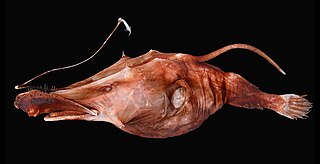
The complete anglerfish (Lasiognathus) is a genus of deep-sea anglerfish in the family Thaumatichthyidae, with six species known from the Atlantic and Pacific Oceans. Its lure apparatus appears to consist of a fishing rod, a fishing line, bait, and hooks. It is also distinctive for an enormous upper jaw with premaxillaries that can be folded down to enclose the much shorter lower jaw.

The anglerfish are fish of the teleost order Lophiiformes. They are bony fish named for their characteristic mode of predation, in which a modified luminescent fin ray acts as a lure for other fish. The luminescence comes from symbiotic bacteria, which are thought to be acquired from seawater, that dwell in and around the sea.

Histiophryne is a genus of marine ray-finned fishes belonging to the subfamily Histiophryninae in the family Antennariidae, the frogfishes. These fishes are found in waters ranging from Taiwan to South Australia. There are currently five known species. These fishes are easily distinguished from other anglerfishes as having a reduced luring appendage, a highly evolved form of the first dorsal fin spine.

Inimicus filamentosus, also known as the filament-finned stinger, barred ghoul, two-stick stingfish, or devil scorpionfish, is a member of the Inimicus genus of venomous fishes. It is a member of the Synanceiidae family of the Scorpaeniformes order of ray-finned fishes. These benthic fishes are found on sandy or silty substrates of lagoon and seaward reefs, in coastal regions of tropical oceans. Like all the other known species of Inimicus, I. filamentosus is a demersal ambush predator. They are nocturnal, and often dig themselves partially into the sandy seabed during the day.
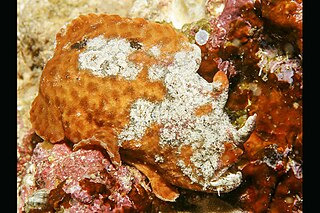
Phyllophryne is a monospecific genus of marine ray-finned fish belonging to the subfamily Histiophryninae in the family Antennariidae, the frogfishes. The only species in the genus is Phyllophryne scortea, the white-spotted anglerfish, smooth anglerfish or smooth frogfish, which is endemic to southern Australia.

Rhycherus is a genus of marine ray-finned fishes belonging to the subfamily Histiophryninae in the family Antennariidae, the frogfishes. The fishes in this genus are endemic to the waters off Australia. This genus is classified in the monogeneric family Rhycheridae, the Balrog frogfishes, by some authorities.

The shaggy frogfish, also known as the hispid frogfish, shaggy anglerfish or zebra anglerfish, is a marine ray-finned fish belonging to the family Antennariidae, the frogfishes. This fish is found in the Indo-Pacific.

The painted frogfish, or spotted frogfish, black angler or painted anglerfish is a species of marine ray-finned fish belonging to the family Antennariidae, the frogfishes. This species is found in the Indo-Pacific region.
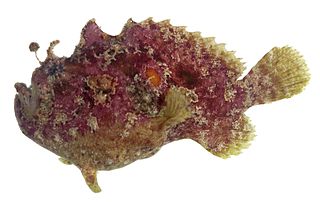
Abantennarius coccineus, the scarlet or freckled frogfish, is a species of frogfish originally classified as Chironectes coccineus and Antennarius coccineus. It lives within tropical waters and has a central distribution being around Indo-East-Pacific areas- excluding Hawaii. The habitat of the scarlet frogfish is in the shallow zones of the ocean. It is found within reef areas, in rocky mounds or sponges where there are places for it to hide amongst from predators. The scarlet frogfish comes in a variety of colours, from tan and brown colours to bright reds and yellows and will grow to a maximum length of 13 centimetres (5.1 in). It can be identified taxonomically through its pectoral rays, the presence of dark patches that appear on its fins and body, along with its lack of distinctive tail base. The scarlet frogfish is not harmful to humans and is not caught by fisheries for consumption purposes, however it has been caught previously for studies relating to the abundance of reef-dwelling fish and as bycatch of shrimp trawling. Similar to other frogfish species, the scarlet frogfish is a predatory carnivore and exhibits a low degree of sociality, only interacting with other scarlet frogfish during their mating period.
Abantennarius analis, the tailjet frogfish, tailjet anglerfish or dwarf frogfish, is a species of marine ray-finned fish belonging to the family Antennariidae, the frogfishes. This species is found in the eastern Indian Ocean and the western Pacific Ocean.
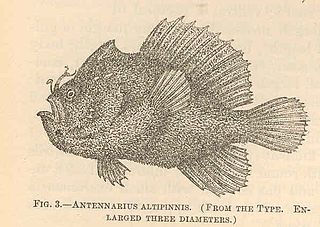
Abantennarius dorehensis, the New Guinean frogfish, bandtail frogfish, Dorei frogfish or white-spotted frogfish, is a species of marine ray-finned fish belonging to the family Antennariidae, the frogfishes. The New Guinean frogfish is found in the Indo-Pacific region.

Antennatus tuberosus, the tuberculate anglerfish, pygmy angler, pygmy frogfish or tuberculated frogfish, is a species of marine ray-finned fish belonging to the family Antennariidae, the frogfishes. This fish is found in the Indian and Pacific Oceans.
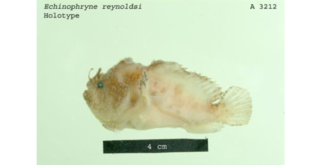
Echinophryne reynoldsi is a species of fish in the family Antennariidae. It was first described in 1984 by Theodore Wells Pietsch III and Rudie Hermann Kuiter.
Rhycherus gloveri, known as Glover's anglerfish, is a species of fish in the family Antennariidae. It is endemic to Australia, where it occurs in rocky reef environments on the country's southern and western coasts. It reaches 16 cm (6.3 in) in total length, and it differs from its close relative R. filamentosus in illicium length and escal morphology. It was named for Dr. C.J.M. Glover (1935-1992), a former ichthyologist of the South Australian Museum.


















